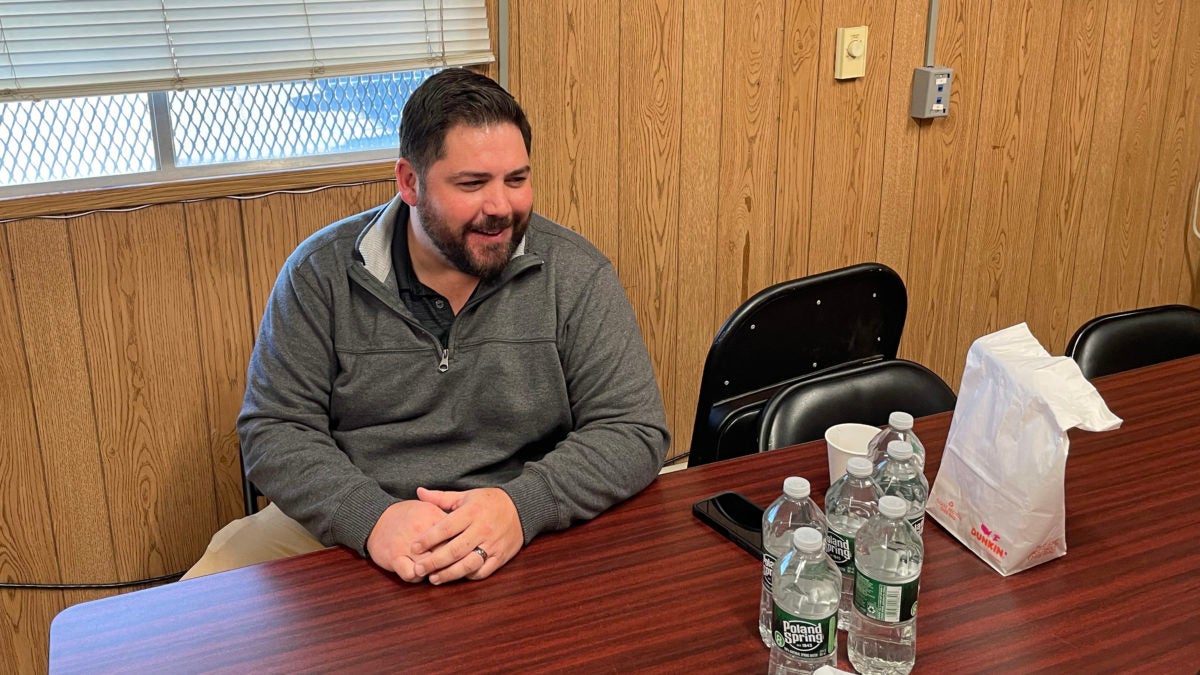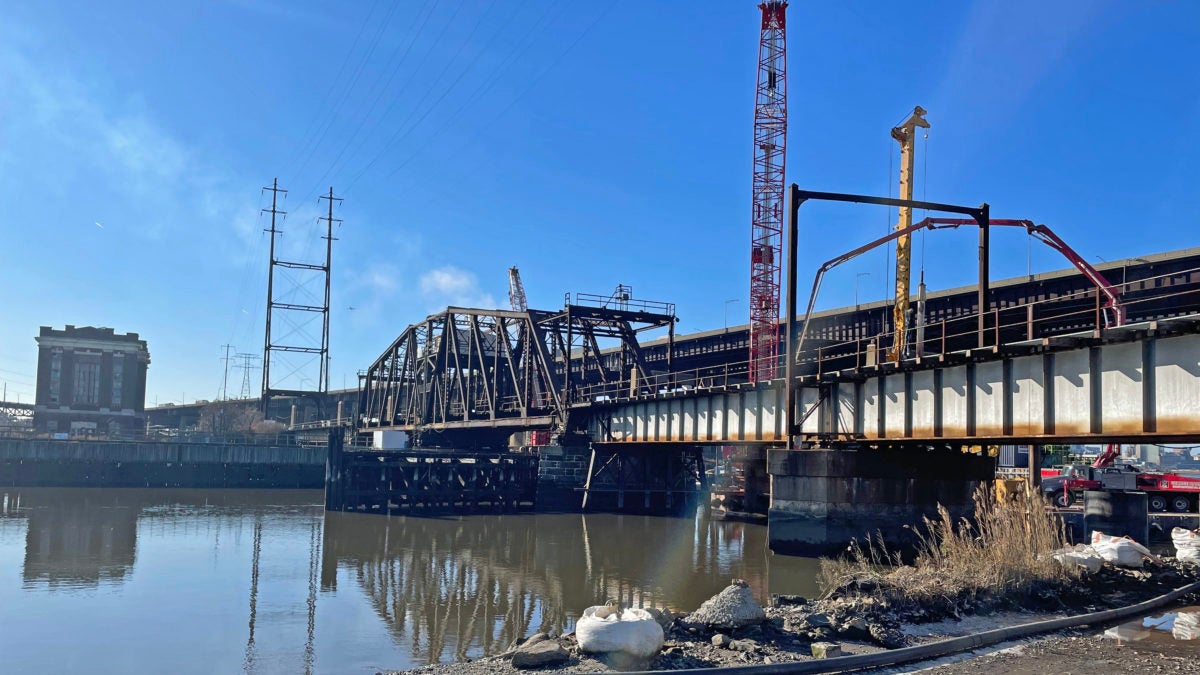KEARNY, N.J. — If the Point-No-Point Bridge in northern New Jersey needs to open for a ship to float by below on the Passaic River, the opening and closing of the drawbridge takes five and a half hours.
When the construction of a new bridge is completed in 2025, the process will take all of five minutes.
Construction of the new bridge on the Conrail system began last summer, according to Ryan Hill, Conrail’s chief engineer of design and construction and the top official leading the project. Hill met with FreightWaves at the Point-No-Point site earlier this month to review the progress of replacing the current bridge, which sees 40 freight trains, often double-stack intermodal trains dozens and dozens of railcars in length, daily cross its route between Newark and Kearny, New Jersey.
The specifics are that the bridge is part of the Passaic and Harsimus rail system that in turn is part of Conrail. The bridge is in an area crossed by multiple railroads. Trains on the PATH transit system run behind a nearby flood wall; beyond that, Amtrak and New Jersey Transit ride by.
Conrail is a unique railroad in that it doesn’t need to have a single salesperson. It doesn’t seek to drum up business. Instead, it operates connecting systems in northern New Jersey, Philadelphia and Detroit on behalf of its two parents, Norfolk Southern and CSX.
Conrail was the name of the federally owned railroad that acquired the bankrupt Northeast rail assets of the Penn Central and Erie Lackawanna railways in the ’70s. When it sold off and split up its assets in the late ’90s to Norfolk Southern (NYSE: NSC) and CSX (NYSE: CSX), federal regulators would not let the sale go through unless a rump Conrail remained to operate regional service in those three aforementioned regions to ensure that neither of the two Class I railroads could dominate service. That’s why it has no sales team; it is there to serve the two lines and doesn’t need to acquire customers. In essence, it has two customers and always will.
“It is a critical link through New Jersey for both of our owners for their through traffic,” Hill said. “Any freight going through northern New Jersey goes through the P&H.”

The P&H in turn has direction connections to all the terminals in the Port of New York and New Jersey, Hill said.
Hill said the Point-No-Point bridge is more than 120 years old. It is what Hill referred to as a “center swing span,” turning on a 90-degree pivot when a ship on the Passaic River needs to pass under it.
“It is at the end of its usable life, so we’ve spent millions of dollars over the past several years just trying to maintain the bridge and keeping it operational,” Hill said.
What is going in its place is not an overhaul of the existing bridge. The new bridge will have a new alignment running parallel to the existing bridge, which eventually will be torn down after the new bridge is in place. The existing bridge will service freight rail up until that point, according to Hill.
Ships don’t transit the Passaic River at that point often, Hill said, measuring the frequency in “a handful of times per year.”
But that is likely to change. The Passaic River is a Superfund site, and remediation of it will involve dredging the riverbed, deepening its draft and allowing larger ships to sail through. Eliminating the lengthy process to open the bridge and keep it out of freight service for more than five hours became a priority. “What we are hearing is that there will be a real increase in marine traffic once that happens,” Hill said.
Hill noted that not only does an opening of the bridge eat up more than five hours of productive time on the railroad, it also means “we have to take seven employees off the normal course of their duties.”
Hill clarified that the Point-No-Point project is not the same as the replacement of the Portal Bridge over the Hackensack River, also in the Newark-Jersey City-Secaucus-Kearny area. That bridge also is ancient and needs replacement. It does carry some freight but it is known primarily as a key link in the Northeast passenger rail, whether it is from Amtrak or New Jersey Transit. Construction on that bridge started several months ago. It too is a swing bridge and sometimes to get it back in place, workers need to wield sledgehammers to align the rails.

Hill said sledgehammers aren’t needed at Point-No-Point. But he did concede that “sometimes it takes some time to work out the kinks there.”
The projected end date for work on the Point-No-Point bridge is September 2025, according to Hill, who said the decision to replace it was made about six years ago and design and permitting took five years. Actual work commenced in July. Hill said work so far has been on schedule.
The type of bridge that will replace it is known as a single bascule single leaf design. A bascule bridge is one in which the lifting of the drawbridge span is countered by a weight at the bottom of the span. The single leaf means that the roadway will not lift with two parts going up in opposite directions. Rather, it is one full segment that will lift toward a 90-degree angle, with the bascule balancing the weight of the rising roadway. (By contrast, the drawbridges in Chicago are double leaf bridges, Hill noted).
And that is the process that will take just five minutes rather than the more than five hours that now gets eaten up any time a ship floats by on the Passaic. And the seven workers now required? Hill said a single dispatcher back at the company’s Mount Laurel, New Jersey, headquarters can take care of the new bridge with the push of a button.
Hill said the cost of the project is estimated at $212 million. There are federal and state grants that will help the funding, but otherwise this is a Conrail private-sector project. (By contrast, the Portal Bridge project is said to carry a price tag of $1.8 billion.)
The current focus is installing the drill shafts into the riverbed. The span will rest on those drill shafts, Hill said.
Continuing to embed the shafts, filling them with rebar and then pouring concrete will go on for several more months, Hill said. “By the middle of next year you should start seeing things that look like a bridge.”
More articles by John Kingston
Wells Fargo lowers stock rating amid wait for TriumphPay’s profitability
M&S expert: Hot market for logistics acquisitions isn’t cooling








Bob W
The correct spelling is Kearny
Alexander czereuta
I believe a new bridge be more elevated for ships to pass underneath without pushing any button(s) elsewhere! Mount olive, n.j. is nowhere near newark/kearney…passaic river!!!